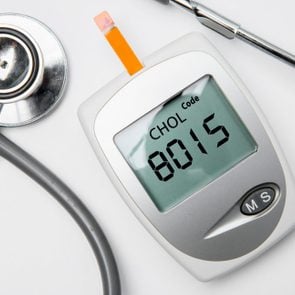Niacin Flush: What It Is and What You Can Do About It
Updated: Jul. 27, 2021
Niacin is often prescribed for high cholesterol, but it comes with some potentially unpleasant side effects. Here's what you need to know about niacin flush.
What is niacin?
Niacin, vitamin B3, is part of the vitamin B complex that plays an important role in keeping the body operating efficiently.
B vitamins help convert our food into the energy it needs to get us through the day. In supplement form, niacin is primarily prescribed as a nicotinic acid to treat high cholesterol levels.
Nicotinic acid supplements come in immediate-release form, in which the whole dose is absorbed by the body all at once, and extended-release, which dissolves more slowly, explains the National Institutes of Health Office of Dietary Supplements.
Nicotinic acid lowers the production of triglycerides and VLDL, leading to decreased LDL (“bad”) cholesterol, increased HDL (“good”) cholesterol, and lowered triglycerides, according to a study in the Journal of Lipid Research. (Don’t miss these other medical reasons you have flushed cheeks.)
What is a niacin flush?
A niacin flush is a side effect of taking too high a dose of niacin supplements.
Although a flush isn’t dangerous, the symptoms can cause discomfort and sometimes pain.
Here’s how it happens: When the body responds to high doses of nicotinic acid, the capillaries expand, which increases blood flow to the skin’s surface, explains an article in the International Journal of Clinical Practice.
A flush appears as red, warm skin, which may be accompanied by an itching or burning sensation.
It’s most common for the skin on the face and upper body to be affected, and it may present as a mild flush, or look deeper and redder, like a sunburn. The skin may tingle, burn or itch, and feel warm or hot to the touch. In some people, the skin may be painful to touch.
How long does a niacin flush last?
Symptoms normally appear about 15 to 30 minutes after taking the supplements and start to disappear after about an hour, according to the British Columbia Drug and Poison Information Centre (BC DPIC).
Niacin flush symptoms could last for one to two hours.
Who gets a niacin flush?
A flush is a very common side effect of the immediate-release form of nicotinic acid—so common, in fact, that at least 60 percent of people taking high doses of the supplements experience it, according to an article published in the journal Mayo Clinic Proceedings.
The recommended daily dietary intake of niacin is 16 mg for adult males and 14 mg for adult females who aren’t pregnant. Serious side effects are most likely if you take between 2,000 to 6,000 mg of niacin a day.
But as little as 50 mg of niacin can cause a flush in some people. And between 5 percent and 20 percent of people stop taking niacin to avoid a flush, according to the Mayo Clinic Proceedings study mentioned above.
The first dose of niacin causes the most intense symptoms. If you continue using it, however, symptoms usually decrease over time.
What are other side effects of niacin?
High doses of niacin can cause other side effects that are more dangerous than a flush.
While these are rare, it is important to be aware of them. The most hazardous is liver damage. If you have a stomach ulcer, you shouldn’t take niacin, as it may cause stomach cramping in high doses.
Experts aren’t sure if women should take the supplement during pregnancy or while breastfeeding, as there may be a risk of trouble for the baby. Because of these possible side effects—and because niacin can interact with other medications you may be taking—you should never self-medicate with niacin.
Only take it under medical supervision and tell your doctor if you experience any side effects or feel unwell. Always ask your doctor questions before taking prescription drugs and these are medication combos you should never mix.
How to prevent or stop niacin flush
There is such a thing as flush-free niacin, containing inositol nicotinate, which the body is supposed to slowly convert to niacin.
However, the BC DPIC warns that there is evidence that it does not actually provide the body with much niacin—which may explain why it doesn’t cause a flush—and therefore has no beneficial effects on cholesterol. BC DPIC recommends starting with low amounts (100 mg) of niacin and gradually increasing the dosage to build up a tolerance and avoid the flush.
Taking niacin immediately after a meal can also lessen the flushing sensation, as can taking an aspirin 30 minutes before taking niacin.
Some research in the Journal of Clinical Lipidology suggests if you eat an apple or applesauce before taking niacin you could reduce your risk of flush.
Make sure to avoid alcohol and hot drinks that may exacerbate niacin flush symptoms.
Research has found that most people develop a tolerance to high doses of niacin over time.
Still, it’s important to discuss niacin with a doctor before taking it.

















